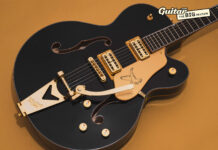
The history of overdriven guitar tones
Where would be today without distortion? Much cleaner, for sure. Much less rock ’n’ roll, maybe. But how did the sound of dirty guitars first invade the grooves of early pop records? A small troop of guitarists led the field, discovering the attraction of a filthy sound primarily through accident, mishap, and serendipity.
Read more: The history of the Gibson Flying V
Back in the early days, recording engineers were trained to avoid distortion, so when these sonic pioneers came along and started purposefully creating an overdriven guitar racket through choice, many of the chaps in charge of the knobs were horrified. Slowly, of course, it dawned on recording personnel that here was a new effect, a new colour to add to the tones available to artists of many and varied stripes. So, join us now as we conjure up six significant scenes of ancient audio dirt.
Memphis Recording Service, Memphis, Tennesse, 1951
Sam Phillips’s Memphis studio became a laboratory for distorted guitar sounds, and an early sign appeared during a visit from Ike Turner and his band in 1951. They were masquerading as Jackie Brenston & His Delta Cats and cut five songs, including Rocket 88, a track that musicologists have since deemed a contender for the title of first rock ’n’ roll record.
The lead guitarist on the session was Willie Kizart. Upon arrival at Sam’s place – or somewhere along Highway 61, depending on which version of the story you believe – Willie’s amp tumbled from the roof of the car and hit the ground. In the studio and plugged in, he figured he was in trouble. An attempt had been made to hold the speaker cone in place by stuffing the amp with paper, and the sound was fuzzy and distorted – someone suggested one of the tubes might also have blown. Willie went ahead and did the best he could, his fuzzed-out guitar riffs powering Rocket 88 with a sound that marked the debut of deliberate distortion. Phillips, to his credit, had no complaints: “The more unconventional it sounded, the more interested I would become in it.”
Soon, more dirt was served up in Sam’s studio. Also in ’51, Willie Johnson pushed his amp on Howlin’ Wolf’s How Many More Years to suitably howling effect. A few years later, Pat Hare added wild sheets of sound to James Cotton’s Cotton Crop Blues and in ’55 Chuck Berry did about 95 on the distortion scale for Maybellene. Memphis fuzz had set the scene.
Bradley Film & Recording Studio, Nashville, Tennessee, 1956
Paul Burlison was one third of The Rock And Roll Trio along with Johnny and Dorsey Burnette, and in 1956 they fetched up at Owen Bradley’s studio in Nashville for sessions spread over a few days. They say history repeats itself, so would you believe that a funny thing happened to Paul on the way to a gig one day? He, too, dropped his amp and a tube came loose. He liked the resulting sound so much he made his amp do the same thing when he plugged in his Telecaster for one of the tracks at the Nashville session.
Paul and the Burnettes were a lively trio with a savage sound, and on these Nashville cuts The Rock And Roll Trio were boosted by a drummer and possibly another guitarist. But it’s Paul’s grinding double-stops and more on their sweaty ’56 single The Train Kept A-Rollin’ that would go down in the history of influential early guitar filth. It would catch the attention of some notable musicians who followed, not least The Yardbirds, who covered it in the 60s and would stretch it out live as the basis for one of their extended crowd-pleasing rave-ups.
Link Wray. Image: David Warner Ellis / RedfernsCameo-Parkway studio, Philadelphia, Pennsylvania, 1958
Here’s a variant on the means to distortion: forget the tubes; consider the speaker cone. As with all our examples here of physical abuse of an amplifier, it comes with a special health warning: there’s a lot of dangerous electricity going on in an amp. Link Wray, though, was probably not one to read health warnings.
Story goes that, at a gig in Virginia, Link Wray & His Ray Men were requested to play a song they didn’t know too well. Instead, Link led the band into some unsettling 12-bar improv, during which his amp began to distort. Or maybe it was the venue’s PA. Wherever it came from, the noise sent the kids wild, and the band were requested to keep playing “that weird song”.
It seemed a good idea to record this evidently popular outing, and Link, ensconced behind the baffles in the studio, sought to recreate the noise that had so inflamed his audience. The method he hit upon was to pierce small holes in the speaker of his Premier amp, which let out an appropriately ragged noise, and he topped it up with some tremolo at the close. They called the result Rumble, and it went Top 20 in May 1958.
Grady Martin. Image: Michael Ochs Archives / Getty ImagesBradley Film & Recording Studio, Nashville, Tennessee, 1960
We’re back at Owen Bradley’s Nashville studio, four years after The Train Kept A-Rollin’. This time, there’s an ordinary country tune going down with singer Marty Robbins. It’s called Don’t Worry and Marty is crooning that one day love is warm, next it’s cold. So far, so country.
Half way in, though, there’s a shocking six-string bass solo. Grady Martin arrives with a heavily distorted sound, playing the Danelectro six-string bass he uses regularly in Nashville studios for the so-called tic tac sound. His fuzzed-out solo is a remarkable noise in such polite surroundings, almost as if the engineer has pushed up a fader linked to a session somewhere else in the building.
The peculiar hubbub was down to a faulty transformer in the studio board, but the producer decided to keep it. Early in 1961, Don’t Worry became a crossover hit for Marty on the country and the pop charts. Meanwhile, the engineer on the session, Glenn Snoddy, teamed up with Gibson and another engineer, Revis Hobbs, to create a unit that could produce distortion whenever required. The result was the Maestro FZ-1 Fuzz-Tone box, introduced in 1962 – of which more shortly.
The Kinks with Ray and Dave Davies. Image: GAB Archive / RedfernsIBC studio, London, 1964
I’m going to repeat what I said about history repeating itself. It was summer 1964, and Dave Davies and The Kinks went into the studio to record their third single, You Really Got Me. There was some pressure growing, because they’d already recorded it a few times in versions slower than the one we know today. The record company wasn’t keen, but The Kinks pressed on.
When Dave walked into IBC on Portland Place, he had with him his trusty Elpico amplifier. It was not in entirely original condition. Some emotional ups and downs with a girlfriend had resulted in Dave taking a razor blade to the amp – so it could have been worse – and he slashed at the speaker cone, echoing Link Wray’s efforts a few years earlier. The sound of the abused little Elpico suited Dave’s mood, providing a distorted, angry tone.
Dave would usually connect the transformed Elpico to an AC30 for added volume, and that may have been the way he used it for You Really Got Me. The distinctive din of his distorted guitar, notably the rasping intro, helped the single to become the group’s first number one hit.
RCA studio, Hollywood, CA, 1965
We’ve seen how Gibson’s Maestro Fuzz-Tone was developed after a studio accident revealed the attraction of a fuzzed-up sound. In 1965, Gibson gave The Rolling Stones a pile of gear, including a brace of Firebirds, several acoustics, some amps, and, most importantly for our purposes, a few Fuzz-Tones.
On tour in America, Keith Richards had come up with a simple riff that he thought could work well for a new song the group had tried out at Chess studios in Chicago and then took with them to the West Coast. He reckoned the riff might become a sort of Stax-style horn line – but then the box of Fuzz-Tones turned up. Now he figured the squawky sound of his guitar through the box could act as a sketch for the horn sound that he could sort out properly later on.
The record company, who needed a single, thought otherwise. (I Can’t Get No) Satisfaction was released in the States and, a little later, in the UK as an A-side after the Stones completed their US tour. It went to number one on both sides of the pond, and suddenly everyone wanted a fuzzbox. At last, distortion had gone mainstream.
A filthy stink for tomorrow
There were others who paved the way by dishing up their own dirty sounds at the dawn of the rock era. We might mention Goree Carter’s Rock A While (1949), or Grady Martin on I Just Don’t Understand by Ann-Margret (1961), or Billy Strange on Zip-A-Dee Doo-Dah by Bob B Soxx & The Blue Jeans (1962). And there’s plenty more where they came from.
Today, of course, we have – at the last count – 11,463 different distortion pedals to choose from, and it seems like we have to follow someone else’s idea of what a fuzzbox should sound like. Maybe, however, we ought to try to get back to the DIY approach of these pioneers and come up with our own take on a new filthy sound. We might even, to use Frank Zappa’s memorable phrase, add something fresh to “the disgusting stink of a too-loud electric guitar”.
For more guides, click here.
The post The history of overdriven guitar tones appeared first on Guitar.com | All Things Guitar.
Source: www.guitar-bass.net












